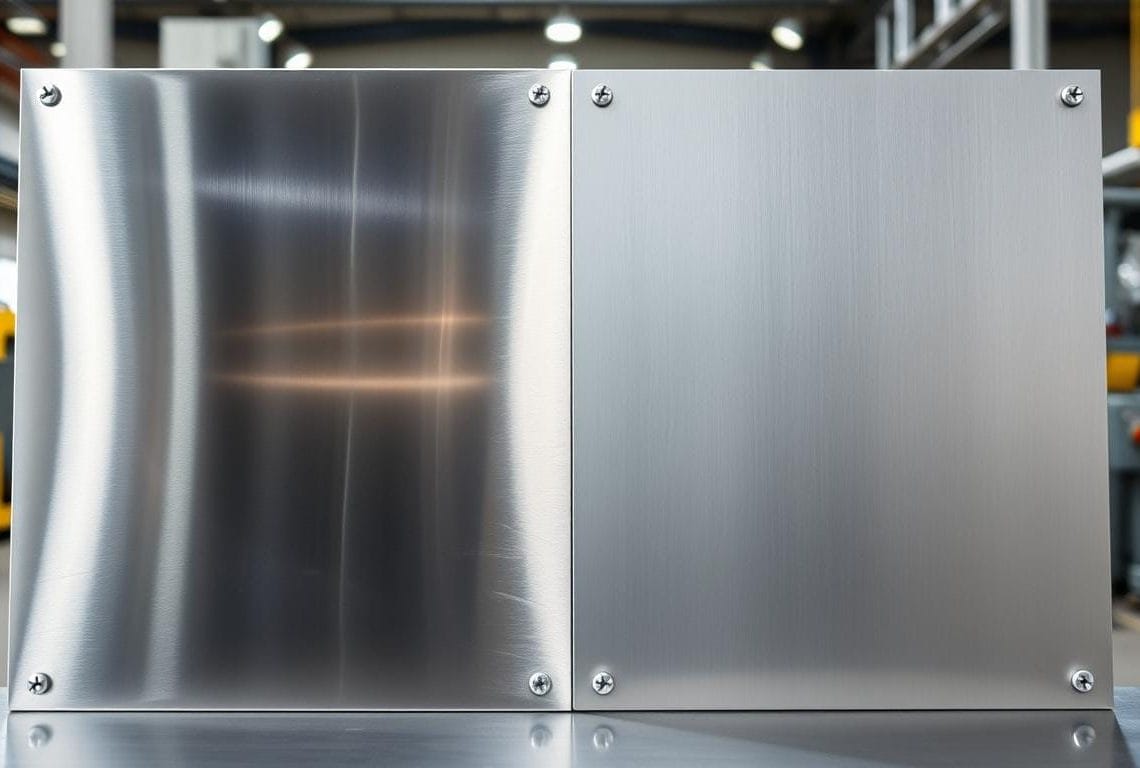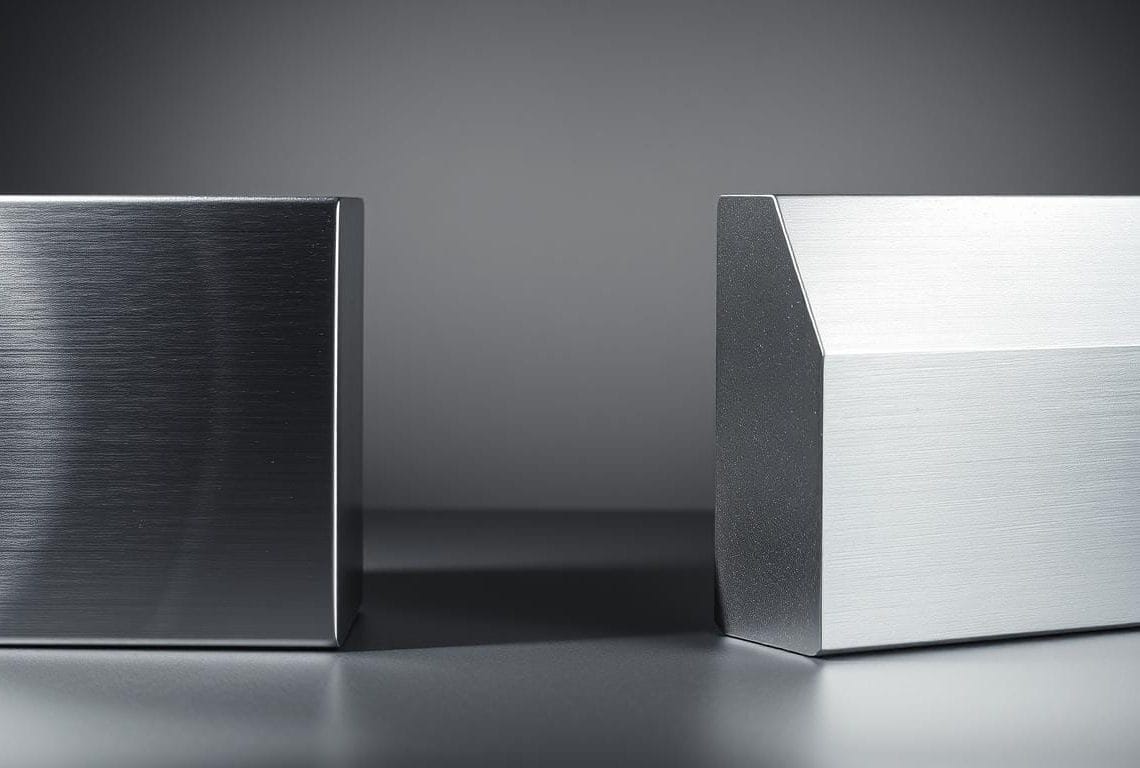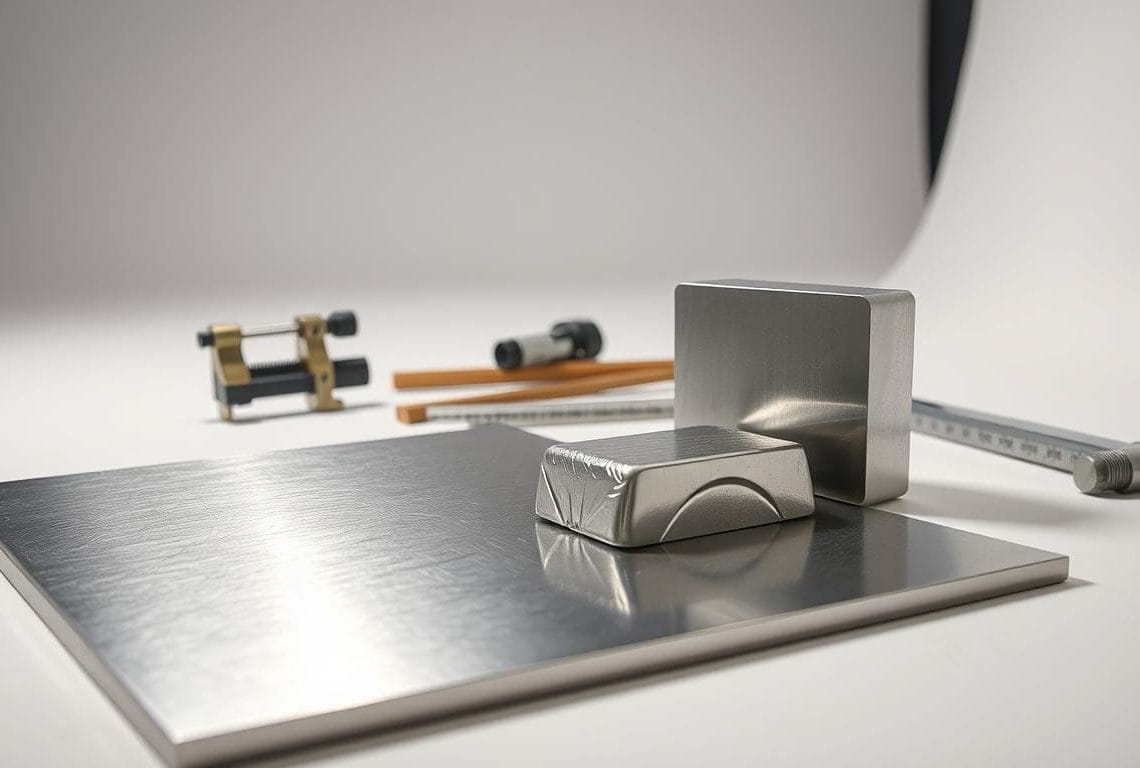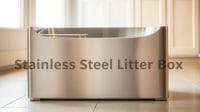A surprising fact is that stainless steel and aluminum are two of the most used metals. They have different properties. Stainless steel is great because it doesn’t corrode easily. Aluminum is light and affordable.
EFA
When we compare stainless steel and aluminum, we need to look at their unique traits. This includes density, strength, and how well they conduct heat. Knowing these helps decide which is better for a project, based on their benefits. Additionally, it’s important to consider the various applications for each material, as different types of stainless steel offer enhanced corrosion resistance and durability compared to aluminum. Each material’s performance can also vary depending on the specific requirements of the project, such as weight constraints or exposure to extreme temperatures. Ultimately, understanding these factors aids in selecting the right material that aligns with the project’s objectives.
In the debate between stainless steel and aluminum, it’s key to understand their basic properties. This includes their chemical makeup, structure, and natural traits. This knowledge helps make the right choice, weighing their benefits. Stainless steel, known for its resistance to corrosion and exceptional strength, is often favored for applications demanding durability. In contrast, aluminum is lighter and more malleable, making it suitable for projects where weight is a concern. To fully appreciate the advantages of each, it’s important to delve into the stainless steel definition and properties, which highlight its versatility and the specific environments where it excels. Additionally, understanding the stainless steel features and benefits can enhance decision-making, particularly in industries like construction, food processing, and medical equipment. Its ability to withstand high temperatures and resist staining makes it the preferred choice for environments that require stringent hygiene standards. Conversely, when weight and formability are prioritized, aluminum’s unique advantages come to the forefront, making it indispensable in automotive and aerospace applications.
Understanding the Fundamental Properties of Both Metals
Stainless steel and aluminum are two metals with different properties. Stainless steel properties include at least 11% chromium, which helps it resist corrosion well. Aluminum, on the other hand, is known for its high strength-to-weight ratio, making it great for when weight matters.
Stainless steel melts at 2500 ℉, while aluminum melts at 1220 ℉. Aluminum starts to soften at 400 ℉, but stainless steel stays strong. The density of aluminum is about 2.7 g/cm³, and stainless steel’s density is 7.9 – 8.0 g/cm³.
Knowing these properties helps decide which metal to use. Stainless steel is often found in kitchens, medical tools, and buildings. Aluminum is used in cars, trains, planes, and power lines. It’s important to understand stainless steel properties and aluminum characteristics to choose the right material.
Some key properties of these metals include:
- Corrosion resistance: Stainless steel is very resistant to corrosion, while aluminum is good but not as much.
- Heat resistance: Stainless steel can handle high temperatures, up to 750 – 1550 °C. Aluminum can handle up to 600 – 660 °C.
- Thermal conductivity: Aluminum conducts heat well, with a range of 205 – 235 W/mK. Stainless steel conducts heat less, with a range of 15 – 25 W/mK.
The Evolution of Stainless Steel Versus Aluminum in Industry
Stainless steel and aluminum have seen big changes in many fields because of their special traits. Stainless steel durability makes it great for places needing strong and corrosion-resistant materials. At the same time, aluminum lightweight benefits make it popular where cutting down weight is key.
In construction and cars, these materials shine in their own ways. Stainless steel’s stainless steel durability is perfect for tough spots. Aluminum’s aluminum lightweight is ideal when weight matters a lot.

Stainless steel has a tensile strength of about 515 MPa to 1300 MPa. Aluminum’s strength starts at 100 MPa and goes up to 400 MPa. Also, aluminum parts are about one-third the weight of stainless steel parts, showing its aluminum lightweight edge.
Choosing between stainless steel and aluminum depends on what the project needs. By looking at stainless steel durability and aluminum lightweight benefits, industries can pick the best material for their projects.
Physical Properties Comparison
Stainless steel and aluminum have different physical properties. Aluminum weighs about 2.7 g/cm³, while stainless steel is around 8.00 g/cm³. This means stainless steel is about three times heavier than aluminum.
Stainless steel is stronger and lighter than aluminum. It has a tensile strength of 510 to 620 MPa. Aluminum’s strength is much lower, at 76 to 84 MPa. But aluminum is better at conducting heat and is lighter, making it great for certain uses.
Weight and Density
Stainless steel is much heavier than aluminum. For the same size, stainless steel is about three times heavier. This is important in industries like aviation, where lighter materials are preferred.
Strength-to-Weight Ratio
Stainless steel has a better strength-to-weight ratio than aluminum. It’s stronger and lighter, making it ideal for durable applications.
Thermal Conductivity
Aluminum is much better at conducting heat than stainless steel. Aluminum’s thermal conductivity is about 205 W/m·K. Stainless steel’s is between 15-25 W/m·K. This makes aluminum great for cooling applications.

Knowing the physical properties of stainless steel and aluminum is key. It helps choose the right material for a job. Factors like density, strength, and heat conductivity are important. They help balance performance, durability, and cost.
Corrosion Resistance and Durability Features
Stainless steel is known for its corrosion resistance. It’s perfect for tough places. Its chromium oxide layer stops corrosive elements, keeping it strong and lasting long. Aluminum also has a protective film but can corrode more easily when near different metals.
304 and 316 stainless steel grades stand out for their top-notch performance in many settings. Aluminum, being cheaper, is often picked for places where weight matters, like in planes and cars.
Here are some main differences between stainless steel and aluminum:
- Corrosion resistance: Stainless steel is better, while aluminum is good but not as strong.
- Durability: Stainless steel lasts longer in harsh conditions, but aluminum can corrode in some cases.
- Cost: Aluminum is cheaper than stainless steel.

In summary, picking between stainless steel and aluminum depends on the job and setting. Thinking about stainless steel corrosion resistance and aluminum cost-effectiveness helps make the right choice for your needs.
Cost Analysis and Economic Considerations
When looking at the cost of stainless steel and aluminum, we must think about the upfront costs, installation fees, and long-term value. Aluminum is often cheaper, with prices between $0.50 and $0.75 per pound. On the other hand, steel costs between $0.20 and $0.60 per pound, based on the type.
The aluminum cost-effectiveness comes from its easy availability. Countries like Australia, Guinea, and Brazil are big producers. Making one ton of aluminum uses 13,000-15,000 kWh of energy, more than steel’s 3,000 kWh. But recycling aluminum saves up to 95% of energy needed to make it from raw bauxite, making it greener.

Stainless steel’s stainless steel benefits include its strength and resistance to corrosion. It’s great for construction, cars, and planes. Stainless steel’s strength is between 520 to 1100 MPa, while aluminum’s is 90 to 570 MPa. It also handles high temperatures well, perfect for applications needing to resist heat.
When comparing stainless steel and aluminum, consider these points:
- Initial material costs
- Installation expenses
- Long-term value assessment
- Energy consumption and environmental impact
- Recyclability and reuse potential
Understanding the costs and benefits of both materials helps industries choose wisely. The decision between stainless steel and aluminum depends on budget, needs, and environmental impact.
Manufacturing and Fabrication Processes
Stainless steel and aluminum have different manufacturing and fabrication processes. Stainless steel is strong and resistant to corrosion, making it perfect for many uses. Aluminum is light and strong, great for the automotive and aerospace industries. Additionally, the durability and longevity of stainless steel contribute to its popularity in construction and kitchenware. For those looking to understand the advantages of this versatile metal, stainless steel properties explained highlight its resistance to staining, heat, and impact. This makes it an ideal choice for applications that require both aesthetic appeal and functionality. Furthermore, the unique stainless steel composition and properties allow for various surface finishes, enhancing its visual appeal while maintaining functionality. This adaptability enables architects and designers to incorporate it into both modern and traditional settings effortlessly. As a result, stainless steel continues to be a preferred material for a wide range of applications beyond those typically recognized. Moreover, the diverse stainless steel alloy properties provide engineers with a variety of options tailored to specific requirements. These alloys can be engineered to enhance particular characteristics, such as increased strength or improved resistance to extreme temperatures. This versatility not only expands the range of applications but also ensures that stainless steel remains a reliable choice in evolving industries.
Working with stainless steel is harder because it’s hard and doesn’t bend easily. But, it can handle high temperatures well and doesn’t corrode. Aluminum is softer and bends more easily. It’s lighter and has a higher strength-to-weight ratio, but it needs extra protection against corrosion.
Some key differences in the manufacturing and fabrication processes of stainless steel and aluminum include: Stainless steel tends to offer greater strength and durability, making it suitable for applications that require resistance to wear and corrosion. Conversely, aluminum is lighter and often easier to work with, which can result in lower manufacturing costs. In a stainless steel vs aluminum comparison, these factors can significantly influence material selection based on the specific needs of a project. In cases where extreme strength-to-weight ratios are critical, a stainless steel vs titanium comparison becomes essential, as titanium offers a high strength while maintaining a lighter profile than stainless steel. Additionally, titanium’s exceptional resistance to corrosion makes it an attractive option for specialized applications, such as aerospace and medical devices, where reliability is paramount. Ultimately, the choice between these materials hinges on specific project requirements, including mechanical properties, environmental conditions, and budget considerations.
- Stainless steel is often produced using electric arc furnaces, while aluminum is typically produced using electrolytic reduction.
- Stainless steel is non-porous, reducing corrosion risk. Aluminum’s oxidation feature provides high resistance to corrosion.
- Stainless steel is stronger and more durable than aluminum. But, aluminum’s lightweight makes it ideal for weight reduction.

In conclusion, knowing how stainless steel and aluminum are made is key to choosing the right material. By understanding their unique properties, industries can improve their production. This leads to creating high-quality products that meet their needs. Additionally, for those exploring the advantages of each material, it is essential to ask, “what is stainless steel made of” to appreciate its corrosion resistance and durability compared to aluminum. This knowledge not only aids in material selection but also in understanding the applications where each material excels. Ultimately, informed choices in material selection contribute to enhanced performance and sustainability across various industries. Moreover, understanding the history behind these materials can provide valuable context for their application. For instance, knowing who is the inventor of stainless steel can inspire innovations in design and technology. As industries evolve, this historical insight combined with material knowledge can lead to groundbreaking advancements and more sustainable practices. Understanding the stainless steel production process further highlights the material’s versatility and strength. This comprehensive knowledge allows manufacturers to optimize their techniques for better efficiency and lower costs. As a result, industries can innovate more sustainably, ultimately driving the demand for high-performance materials in a competitive market.
Environmental Impact and Sustainability
Looking at the environmental impact of stainless steel and aluminum, we see key points. Stainless steel is highly recyclable, with most new steel coming from recycled sources. Aluminum, on the other hand, is 100% recyclable and keeps its quality forever.
Recycling aluminum uses less energy and time than steel. It’s also cheaper to recycle aluminum than steel.
Carbon Footprint
Research shows steel is better for the environment than aluminum in some ways. But, as more aluminum is recycled, the difference in environmental impact gets smaller.
Recyclability
Most aluminum produced is still in use today. Aluminum cans often have over 50% recycled content. Recycling an aluminum can back to a store takes just 6 weeks.
Energy Consumption in Production
Producing virgin aluminum needs a lot of energy, more than making trade-mix steel. Yet, both materials have benefits for sustainable development. Knowing about their environmental impact helps us all reduce waste and pollution.
Common Applications and Industry Usage
Stainless steel and aluminum are key materials in many industries. Stainless steel is strong and resists corrosion, perfect for building and cars. Aluminum is light and strong, great for planes and packaging.
Stainless steel is used in turbine engines and chemical plants. It handles high heat and strength well. Aluminum is in cars and planes because it’s light and strong. It also helps planes use less fuel and pollute less.
Choosing between stainless steel and aluminum depends on what you need. Stainless steel costs more but lasts longer and is stronger. Aluminum is cheaper and lighter, ideal when weight matters. Here are some main uses for each: Stainless steel is commonly used in kitchen appliances, cutlery, and medical instruments due to its durability and resistance to corrosion. On the other hand, aluminum often finds its place in the aerospace and automotive industries where weight savings are crucial. When considering materials like stainless steel vs sterling silver, it’s important to reflect on the desired aesthetics and functionality because sterling silver, while beautiful, requires more maintenance and care.
- Stainless steel: construction, automotive, chemical processing, and turbine engine components
- Aluminum: aerospace, packaging, automotive components, and bicycle manufacturing
In summary, picking stainless steel or aluminum depends on your needs. Knowing their strengths helps industries choose the right material for their projects.
Maintenance Requirements and Longevity
Stainless steel and aluminum need different care. Stainless steel is durable and easy to maintain. It lasts long with just regular cleaning and checks.
Aluminum is light and easy to care for too. But, it might need more checks and fixes, mainly in tough spots.
To keep these materials going strong, follow the right cleaning steps. For stainless steel, steer clear of harsh cleaners and use mild ones. Aluminum needs a soft cloth for cleaning to avoid scratches.
Cleaning Procedures
- Use gentle cleaning products for stainless steel
- Avoid harsh chemicals and abrasive materials
- Use a soft cloth for cleaning aluminum perse
Preventive Measures
Regular checks and upkeep can stop damage and make these materials last longer. Look for wear and fix problems fast.
Life Expectancy
The life span of stainless steel and aluminum depends on many things. Quality, how they’re used, and care all play a part. Stainless steel can last decades with the right care. Aluminum might not last as long because it’s softer.
Aesthetic Properties and Design Possibilities
When we talk about looks and design, stainless steel properties and aluminum characteristics are key. Each has its own strengths and weaknesses. Stainless steel is loved for its modern look. Aluminum is great for being versatile and easy to customize.
Aluminum is much lighter than stainless steel. This makes it simpler to work with and install. This is a big plus in places like the car industry. Learn more about the differences between stainless steel and aluminum.
Here are some main points about stainless steel and aluminum’s looks and design:
- Corrosion resistance: Stainless steel is better at fighting off corrosion than aluminum. This makes it perfect for tough environments.
- Malleability: Aluminum is softer and easier to shape than stainless steel. This is great for making detailed designs.
- Thermal conductivity: Aluminum is better at handling heat than stainless steel. This is useful in situations where cooling down is key.
In summary, stainless steel and aluminum are both great for many uses. Knowing what each material can do helps designers and engineers choose the right one for their projects.
Performance in Extreme Conditions
Stainless steel and aluminum both shine in extreme conditions. Stainless steel fights off corrosion and can handle very high temperatures. Aluminum, on the other hand, is light and resists corrosion well, perfect for places where weight matters.
Stainless steel can handle temperatures up to 750-1550 °C, depending on the type. Aluminum tops out at 600-660 °C. This makes stainless steel great for very hot jobs. But aluminum is better at conducting heat, which is good for cooling systems.
Temperature Tolerance
Stainless steel keeps its strength even when it’s very hot. This is why it’s used in defense, oil, and gas. Aluminum, though, gets stronger when it’s cold. This makes it perfect for the aerospace and marine fields.
Want to know more about aluminum and stainless steel? Check out aluminum vs stainless steel. There, you’ll find out about their main features, physical traits, and how they affect the environment.
Weather Resistance
Stainless steel is top-notch against corrosion thanks to a chromium oxide layer. It’s ideal for tough spots, like places with lots of chloride. Aluminum also has a protective oxide film but can corrode more easily when near other metals.
Safety Considerations and Regulatory Standards
Working with stainless steel and aluminum comes with safety risks. Stainless steel properties like high strength and corrosion resistance are great for building and making things. But, handling heavy steel can cause falls, burns, cuts, and crush injuries.
Aluminum characteristics like being light and good at cooling down are useful in many areas. But, aluminum can be dangerous if not handled right. Its protective layer can also get damaged by some chemicals.
To stay safe, it’s important to follow safety rules. This includes checking equipment often, training on PPE, and having plans for emergencies. Some key safety tips are:
- Using the right lifting methods to avoid injuries
- Checking machines and tools regularly to make sure they work well
- Working together to find and fix risks
Knowing the safety issues and rules for stainless steel and aluminum helps make workplaces safer. Following safety laws is very important. Regular training and inspections help everyone follow rules and keep the workplace safe.
Making the Right Choice: Material Selection Guidelines
Choosing between stainless steel and aluminum involves several important factors. Stainless steel is known for its durability and corrosion resistance. It has a tensile strength of 515 MPa to 1300 MPa. On the other hand, aluminum is lighter and has a better strength-to-weight ratio, with tensile strengths from 100 MPa to 400 MPa.
The cost of each material varies based on the application. Aluminum might be more cost-effective when priced by volume or component. This is different from stainless steel, which is often priced by weight.
Both stainless steel and aluminum are highly recyclable, which helps reduce energy use in secondary production. Stainless steel is one of the most recycled materials because it’s magnetic. It has also made big strides in reducing carbon emissions through modern production.
Aluminum, on the other hand, requires less energy to recycle than it does to produce initially. When choosing a material, consider the advantages of each. Look at corrosion resistance, thermal properties, machinability, and aesthetic appeal. This will help you make a choice that meets your specific needs and provides long-term value.






